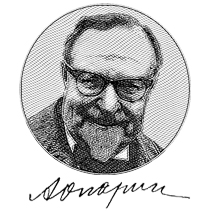International Conference
THE PROBLEM OF THE ORIGIN OF LIFE
Youth Scientific School
MOLECULAR AND CELLULAR BASIS
OF THE EARLY EVOLUTION OF LIFE

Moscow – September 22-26, 2014

IN RETROSPECT
The Origin of Life
 “Oparin belongs in the
pantheon of the twentieth century’s greatest scientists for pro-viding
a foundation for understanding early molecular evolution.”
– write in the Nature Clifford P. Brangwynne of MPI of
Molecular Biology and Genetics in Dresden and Anthony A. Hyman of
Princeton University.
“Oparin belongs in the
pantheon of the twentieth century’s greatest scientists for pro-viding
a foundation for understanding early molecular evolution.”
– write in the Nature Clifford P. Brangwynne of MPI of
Molecular Biology and Genetics in Dresden and Anthony A. Hyman of
Princeton University.
(see Brangwynne, C. P and
Hyman, A.A. IN RETROSPECT: The Origin of Life. | NATURE | VOL 491
| P. 524 – 525.)
Below follow excerpts from this
article.
“No religious or philosophical sys¬tem, no outstanding thinker
ever failed to give this question seri¬ous consideration.” So wrote
Aleksandr Oparin more than 75 years ago, about the quintessential
conundrum of how life self-assembled from inanimate components. The
Soviet biochemist’s answer is his book The Origin of Life (1936). Roughly
based on a pamphlet he published in 1924, this book is an enormous
contribution to our under¬standing of life’s improbable beginnings. In
it, Oparin argues that conditions on early Earth nurtured the synthesis
of amino acids and their assembly into protocells. Nearly 20 years
after the book’s publication… Stanley Miller and Harold Urey tested
Oparin’s hypothesis in a lab at the University of Chicago in Illinois.
They sent a continuous electric current through a glass vial
contain¬ing water, hydrogen, methane and ammonia...(and) a substantial
amount of the carbon had been converted into complex macromolecules,
including many amino acids. This ‘Miller–Urey’ experiment con¬firmed
the significance of Oparin’s ideas, and Miller duly referenced The Origin of Life.
Oparin’s work thus played a seminal part in the formulation of our
modern ideas of life’s conception. His ideas on the organiza¬tion of
cells and first stirrings of life con¬tinued to attract an important
audience.
Today, the primary legacy of The
Origin of Life is the Miller–Urey experiment, but the synthesis
of amino acids took up just part of the book. Oparin went on to
describe a mechanism by which macromolecules would self-assemble into
large liquid-like structures that he called “complex coacervates” —
what today might be called colloidal assemblies. He suggested that
these protocells were a key step in the origin of life. However, given
the uncertainty at that time about the nature of biological
macromolecules, it was unclear exactly how these colloids might
form.
…current cell and molecular biology provides a new perspective on the
feasibility of life beginning from liquid-like macromolecular
assemblies, suggesting that Oparin might have been more correct than he
thought. Many macromolecules have weak multivalent interactions with
other macromolecules, which means they have several sites at which
interaction can occur. RNA itself is a flexible, extended, dynamic
molecular chain; the interactions between it and other molecules are
typically numerous and weak. These properties are sufficient for
macromolecules to self-assemble into liquid-phase droplets, like
Oparin’s coacervates. Recent work on RNA compartmentalization and
catalysis in liquid droplets provides addi¬tional support for Oparin’s
concept of primi¬tive protocells in a primordial ‘RNA world’.
Oparin belongs in the pantheon of the twentieth century’s greatest
scientists for pro¬viding a foundation for understanding early
molecular evolution. He believed that natu¬ral selection had
“completely wiped off the face of the Earth all the intermediate forms
of organization of primary colloidal systems and of the simplest living
things”. Three-quarters of a century before Oparin, Charles Darwin
noted that such primitive life forms would be a poor match for
contemporary, highly evolved ones. But Darwin also wrote that
relatively less-evolved species — “anom¬alous forms … living fossils” —
often come down through the ages, against all the odds.

